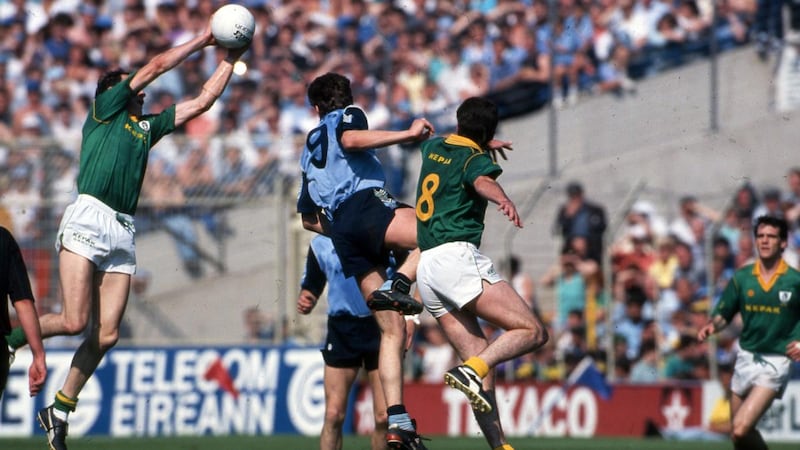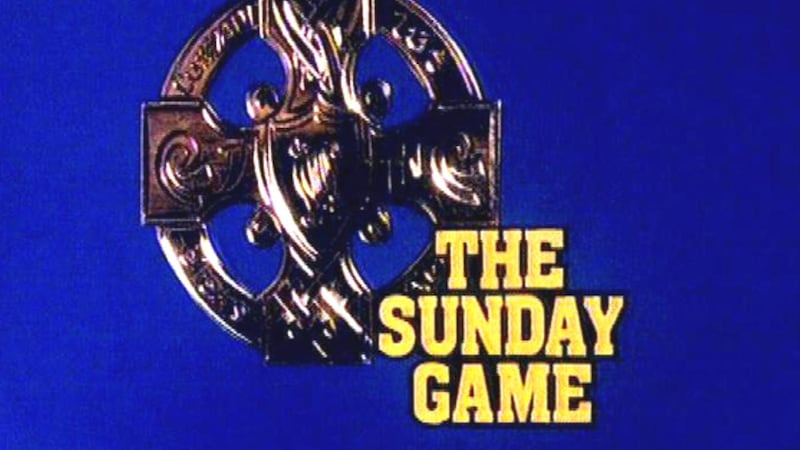On Sunday evening, RTÉ’s Sunday Game returns – so integral to the nation’s summer that it has to be there even if the games aren’t. The programme is also marking a significant anniversary.
Twenty-five years ago this month, the live weekly broadcast of championship matches began. The starting point was not auspicious. From the GAA congress in April that year, there had been a long-running row between the association and RTÉ about the terms of the new agreement.
It ran so long that The Sunday Game for that year didn’t even get up and running until the last weekend in May.
For Liam Mulvihill, the GAA's director general, it was intensely frustrating. On the one hand he knew the association needed to move with the times and start showcasing its matches in live broadcasts but on the other, he was leading a sceptical organisation.
"Liam typically was ahead of the posse," says former GAA commercial and marketing manager Dermot Power. "He saw the benefits of promotion in broadcasting the games live and felt that we had to be in that space.
“There was a real concern about the impact on attendances and we’re seeing at the moment how important television income is for other sports to the extent that they’ll play behind closed doors. For the GAA it was – and still is but not to the same extent – absolutely the only major income stream.”
These days with an average season featuring more than 40 live matches, it can be hard to understand that there were significant doubts about the potential audience, at that stage used to just All-Ireland semi-finals and finals going out live.

By the 1990s, the GAA had started to show the odd match, generally if a head of steam had built up in a fixture, for instance the last of the four-match Meath-Dublin epic in 1991 and that same weekend, the Munster hurling final between Cork and Tipperary.
There were other less successful ventures. An Offaly-Wicklow Leinster championship replay in 1994 drew a crowd that barely hit four digits – symbolic of the pitfalls as well as the unusually positive disposition of then provincial secretary, Michael Delaney.
“Leinster was better able to use Saturdays and bank holidays,” he recalls. “Distances weren’t as great as in some of the other provinces and venues not as far away. That was a Saturday match we allowed as a favour to RTÉ, Wicklow and Offaly, a replay in Tullamore, and there was nobody at it.
"But I was always of the opinion that as Oliver J Flanagan, who was a TD for down here, used to quote: 'There's no such thing as bad publicity!'"
Even in RTÉ there was no consensus on whether it was a good idea. Now retired, Michael Lyster was about to be one of the most affected. As presenter of the established highlights programme, he would also have to front the live broadcast and he wasn't convinced.
“Live was a huge change and I didn’t think it was going to work at the time. The first year we went on air at six o’clock on a Sunday evening. It was just a small audience. It was Tim O’Connor’s idea and at the end of 1995, he mentioned that we were going to try and get the GAA to go for three o’clock the following year.
“I said, ‘are you mad – whatever about tea-time when people are at home, who’s going to watch on a summer afternoon? I’ve no clue how he was right but he was.”

As the cards fell, the first fixture in the new agreement was the Leinster championship meeting in Newbridge of Kildare and Louth, who won narrowly. Their man-of-the-match with 0-7, five from play, was centre forward Colin Kelly, who went on to manage his county and later, Westmeath.
“There was added pressure of the match going out live on tv,” he says, “and there was a bigger media presence because of that as well as in the build-up because it was the first live provincial match. The six o’clock start was strange and we had to hang around all day to play on a Sunday evening so the logistics for the management were challenging.
“It was blustery but there was a good atmosphere in St Conleth’s Park. It was very unusual in those days and there wasn’t at first the same level of analysis and looking at referees that we’re used to now.”
The six o’clock throw-in was intended to mollify GAA concerns about the impact on other attendances. It meant that some fixtures, which went ahead in the afternoon, got shown on a deferred broadcast and overall the slot yielded poor results.
“There was a consensus that the six o’clock starts did not work – and the live audiences were patchy,” was Mulvihill’s considered verdict at the time.
“A bit of a disaster,” is Delaney’s more forthright recollection.
The idea was dropped for 1996.
If it appears unusual that RTÉ would have agreed to it in the first place, Power makes an obvious point. “That was reflected in the rights fee but RTÉ saw the potential and were happy to buy into the process because they knew it would be a process.”
The value of the media rights package 25 years ago was roughly €520,000 and covered just the television highlights and negligible overseas rights. The Central Statistics Office index links that at just over €800,000. Current media rights are worth over €14 million a year.
Mulvihill’s thoughts two years later were prophetic.
“Due to the absence of competition in this country, we will have to look at ways of segmenting our available programming in order that we can attract a wider range of broadcasters than heretofore. In my opinion, we should not give exclusive rights to any one station . . . ”
The move into live broadcasting was central to the evolution of these figures. Even after one year the income had started to climb to just under a million euro. This was despite RTÉ’s monopoly position in the Irish market, something Mulvihill frequently lamented.
Relations between Croke Park and the late Tim O’Connor, RTÉ’s head of sport, were fractious but although at the time he used to deny exploiting his dominant position, the fact remains that he was a buyer in a buyers’ market.
“Tim hated the GAA,” remembers Lyster. “He f***ing hated them! In fact back in those days when things were negotiated at sports level – which they’re not any more – I used to sit in on some of those things. You’d think we were going into battle! But it was Tim who put the live stuff in place.
“The first year that we did it, we paid the GAA £30,000 for every match to cover loss of revenue. That lasted two years and everything changed after that.
“Importantly, this was at the time that Sky had started with coverage of Premiership soccer. We had to ask ourselves are we in this game or are we out of it?”
Power views the relationship dynamic with equanimity but says that the GAA made a valuable connection at the time, the services of London sports media consultancy, Oliver + Ohlbaum.
“Tim was feigning a lack of interest,” he says, “but we managed to get the figures back up into a more commercial area pretty quickly. We used Mark Oliver and he was very helpful in giving us a completely objective view of the value of the rights.”
He also had to deal with unrealistic expectations from within the association.
“There was also a misunderstanding of the value of GAA rights, particularly in the international dimension. There were a lot of people who couldn’t understand why hurling – which we would all agree is one of the great games to watch but to a non-Irish audience, unfortunately doesn’t have the same connection – wasn’t being shown all over the world.
“If American networks thought any sport would draw a crowd, they’d show it. I was at the sports media convention in Miami one year and I met some of the Eurovision people and thought I had a deal to take the hurling semi-finals and final for not huge money but to get the idea started. At the last moment they came up with – I think it was – a cycling event and said their schedules were now full. Internationally that’s what you’re up against.”
It was also the summer of the first Guinness advertising campaign in the company’s sponsorship of the hurling championship and throughout the rise of Ger Loughnane’s Clare, on the way to a first All-Ireland in 81 years. Arguments about the impact on crowds fizzled out and the GAA’s television age had truly begun.
It’s something Delaney has had reason to be thankful for in his own retirement.
"I was talking to [Kildare and national official] Pierce Freaney recently and we were saying that when we were tied up in organisation, we only ever got to see the highlights. In the last few weeks, I'm only now looking at matches I never saw in full at the time."
* The Sunday Game returns this Sunday when Des Cahill will be joined by guests Stephen Rochford, Ciarán Whelan, Cyril Farrell, Anthony Daly and this week, GAA president John Horan for a look back at great matches from the past. Programme one features Dublin v Mayo in the 2017 All Ireland football final and Clare v Galway in the 2018 All Ireland hurling semi-finals.



















